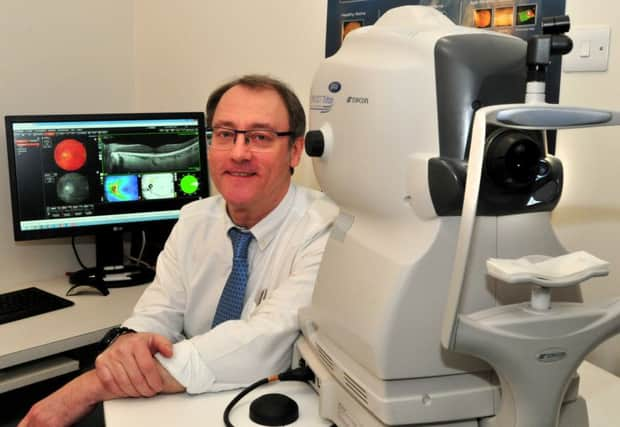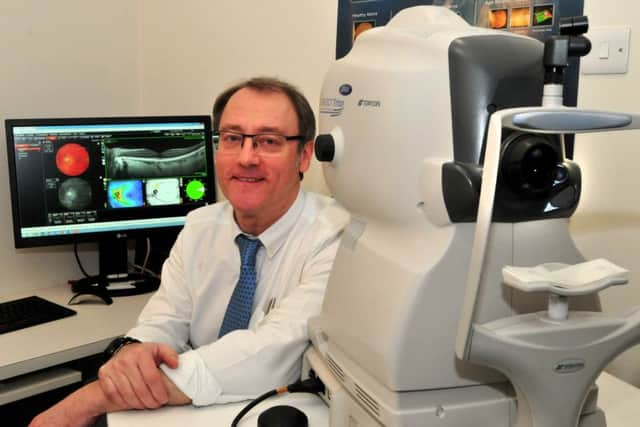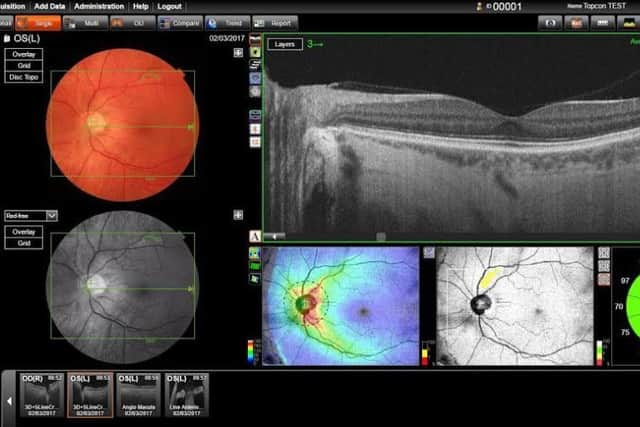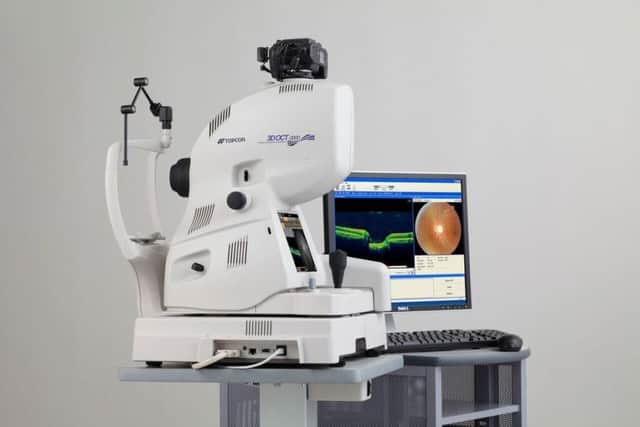State-of-the-art 3D eye screening brings new vision to Carnforth opticians


OCT – Ocular Coherence Tomography – is an advanced eye scan which can be used to examine the eyes of people of all ages.
Claiming to “go boldly where no optical equipment has gone before” the scanner has been designed to find major medical conditions simply by examining your eyes.
Advertisement
Hide AdAdvertisement
Hide AdWorking in a similar manner to an ultrasound, the OCT scanner uses light rather than sound waves to reveal the many layers that make up the back of the eye.


The OCT machine captures both a photograph and a cross-sectional scan of the eye at the same time.
Put simply, if you are looking at an iced cake before it has been sliced, you don’t know if it contains jam, cream or chocolate layers; equally if it’s lumpy or smooth.
With this unique non-invasive technology your optometrist is able to see both the surface of the back of your eye (the top of the cake) and a three dimensional image of the layers that are beneath the surface.
Advertisement
Hide AdAdvertisement
Hide Ad3D OCT screening can detect potentially serious conditions which can affect your eyesight and your overall health, including glaucoma and diabetes.


Using a state-of-the-art 3D OCT camera, the optometrist will take both a digital photograph and a 3D scan of the back of your eye in one sitting.
They can then review the images on a PC screen and pinpoint areas of concern.
This allows both instant and early diagnosis of a number of common ocular conditions.
The scan is non-invasive, painless, simple and quick.


Advertisement
Hide AdAdvertisement
Hide AdWhat’s more, the software can automatically detect even the most subtle changes to the retina with every eye test you have.
The machine also examines blood flow around the eye.
This gives an invaluable ongoing record of the health and condition of your eyes.
Using this machine, your optometrist can more confidently diagnose, manage or refer you to an eye doctor for further treatment, should this be required.


For the majority of patients, OCT provides significant reassurance that the deeper layers of their eye are healthy.
Advertisement
Hide AdAdvertisement
Hide AdPhilip Jones Opticians in Carnforth is the first in the region to try out an OCT scanner, and the team has so far been impressed with the results.
“OCT scanning has been around for a while but we decided that this was the time to try it out,” Mr Jones said.
“The software is so advanced now.
“We can spot a problem straight away which might otherwise take a lot longer.”
Optometrists using the technology can also access an online support network of other experts who can look at the scans to help with diagnosis.


Advertisement
Hide AdAdvertisement
Hide Ad“It has given extra reassurance, because we can spot things sooner and get things fixed sooner,” said Mr Jones.
“I can tell the hospital what I think has happened and what they can look for.
“Patients are really impressed. We have been looking after people’s eyes for 15 years, and this machine means we can can monitor people’s progress much better.
“I am particularly interested in clinical optometry, looking after the health of the eye.
“We are trying to keep more people out of hospital.
Advertisement
Hide AdAdvertisement
Hide Ad“Optometry has moved on a lot in my career. We are now taking more responsibility for people’s eye care and having the digital equipment helps with that.”
Having been blessed with progressively poor eyesight, coupled with double vision, since I was seven, I am used to having regular eye tests.
However, I was still slightly nervous about what exactly might be found by the OCT scanner.
The scan showed up a slight vitreous detachment in my left eye. This means the vitreous jelly in the eyeball has become less firm and moved away from the back of the eye towards the centre.
Advertisement
Hide AdAdvertisement
Hide AdIt is not painful and does not alter your eyesight, and I was assured this is a normal occurrence as people age, and that it was very slight in my case and would be monitored for further change.
The scan also showed up floaters in my right eye, something which is common in people with short sightedness.
They are caused by clumps or specks of undissolved vitreous gel material floating in the dissolved vitreous in the back of the eye, which cast shadows on the retina when light enters the eye.
All in all, it was a relief to hear my eyes were in pretty good condition considering, with nothing major to worry about.
Advertisement
Hide AdAdvertisement
Hide AdThere may be an additional charge for the OCT scan, but the benefits are obvious; either you can be sure that any concerning changes in your eyes are detected, monitored and treated swiftly, or you can enjoy the peace of mind that comes from knowing that your eyes are in great condition.
OCT screening: The facts
Common conditions identified through regular OCT screening include:
* Age-related macular degeneration – this is the leading cause of blindness in the UK
* Diabetes – more than four million people are now diagnosed with diabetes in the UK
Advertisement
Hide AdAdvertisement
Hide Ad* Glaucoma – some form of this condition affects around two in every 100 people over 40
* Vitreous detachments – a painless condition which damages the back of the eye
* Macular holes – a condition which requires hospital treatment